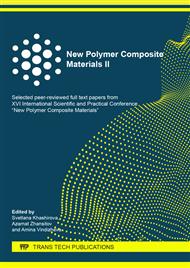[1]
M. Kotsevman, Polymer composites and localization, The Chem. J. 1-2 (2013) 66-69.
Google Scholar
[2]
A.C. Kolosova, M.K. Sokolskay, I.A. Vitkalova, A.S. Torlova, E.S. Pikalova, Modern polymer composite materials and their application, International Journal of Applied and Basic Research. 1 (2018) 245-256.
Google Scholar
[3]
E. Kablov, Composites: today and tomorrow, Science and technology. 1 (2015) 36-39.
Google Scholar
[4]
T. Blythe, D. Bloor, Elecctrical Properties of Polymer, Cambridge University Press, 2005. pp.256-350.
Google Scholar
[5]
A.C. Kolosova, M.K. Sokolskay, I.A. Vitkalova, A.S. Torlova, E.S. Pikalova, Fillers for the modification of modern polymer composite materials, Basic research. 3 (2017) 59-65.
Google Scholar
[6]
D.M. Kadirov, S.E. Nefelev, D.M. Kadirova, E.S. Nefelev, Self-regulating conductive heating composition, Bulletin of Kazan Technological University. 16 (2013) 123-125.
Google Scholar
[7]
M.E. Savinova, Electrically conductive polymer composite materials for electrical purposes, University News. North Caucasus region. Technical science. 4 (2015) 44-49.
Google Scholar
[8]
Y. Fang, J. Zhao, J.W. Zha, D.R. Wang, Z.M. Dang, Improved stability of volume resistivity in carbon black/ethylene-vinyl acetate copolymer composites by employing multi-walled carbon nanotubes as second filler, Polymer. 53 (2012) 4871-4878.
DOI: 10.1016/j.polymer.2012.08.035
Google Scholar
[9]
M. Rahaman, T.K. Chaki, D. Khastgir, Control of the temperature coefficient of the DC resistivity in polymer-based composites, J. Mater. Sci. 48 (2013) 7466-7475.
DOI: 10.1007/s10853-013-7561-9
Google Scholar
[10]
M. Kalantari, M. Ramezanifard, R. Ahmadi, J. Dargahi, J.A. Kovecses, Piezoresistive tactile sensor for tissue characterization during catheter-based cardiac surgery, Int. J. Med. Robot. Comput. Assist. Surg. 10 (2011) 431-440.
DOI: 10.1002/rcs.413
Google Scholar
[11]
I.A. Morozov, A.L. Svistkov, G. Heinrich, B. Lauke, Frame structure of aggregates of carbon black particles in filled elastomeric materials, Polimer Sci. Part A. 49 (2007) 456-464.
DOI: 10.1134/s0965545x07030091
Google Scholar
[12]
J. Frohlich, W. Niedermeier, H.D. Luginsland, The effect of filler-filler and filler-elastomer interaction on rubber reinforcement, Composites, Composites. A. 36 (2005) 449-460.
DOI: 10.1016/j.compositesa.2004.10.004
Google Scholar


